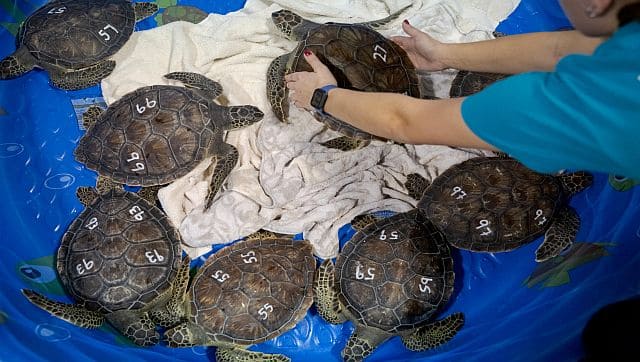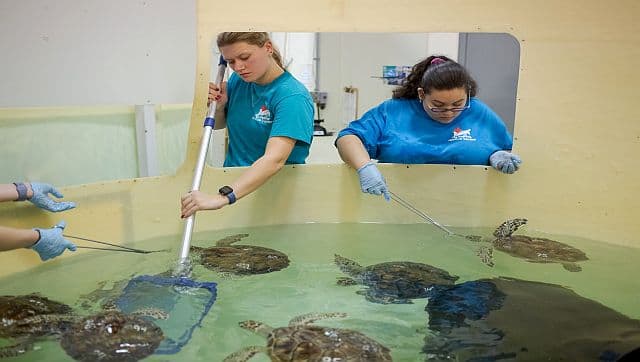On a recent Thursday morning, Maxine Montello was at work making breakfast for 48 hungry diners. She had a stack of numbered plastic trays, and a clipboard with a list of corresponding menu orders. Methodically, she placed each tray on a scale, cut up pieces of frozen squid and cold raw herring and added them — including heads and tails — measuring just the right amount. Pills were hidden inside some of the fish, and Montello referred to notes about her customers. “Some of them don’t like the tails,” she said. “And No 7 doesn’t like the squid.” The feast was not for picky eaters at an upscale restaurant. Montello is the rescue program director at the New York Marine Rescue Centre in Riverhead, Long Island, a nonprofit organisation stretched to its limits after receiving a record number of sick sea turtles in urgent need of aid this season. It is the only marine mammal and sea turtle rehabilitation centre in New York state. When it comes to wildlife associated with the New York region, you might think of the beaver, a rodent on the official seal of New York City; the rat, which quietly scuttles among us; or the deer, which frolics in the Bronx and on Staten Island as well as across Long Island. The sea turtle swims under the radar. “Even people that might spend a fair amount of time on the water in the Northeast might never see a sea turtle,” said Barbara Schroeder, the sea turtle coordinator for National Oceanic and Atmospheric Administration Fisheries. “But they do use Northeast waters extensively.” Montello recently heard about one being caught and released by fishermen between the Bronx-Whitestone Bridge and Robert F Kennedy Bridge. The rescue centre mainly sees two types of sea turtles: green and Kemp’s ridley. Both varieties generally travel north in the summer and spend winters in warmer waters down south. The green sea turtle, a threatened species with a beautiful starburst pattern on its shell, can be found all over the world. The Atlantic Ocean population often nests in Florida and travels as far as Massachusetts in the summer. They live to about 70 years old, growing to three feet long and 350 pounds. [caption id=“attachment_12220862” align=“alignnone” width=“640”] Turtles at the Marine Rescue Centre, where the cold-stunned mammals can be rehabilitated, and also numbered, weighed, and measured for tracking and research, on Long Island in Riverhead, New York. Anna Watts/The New York Times[/caption] The Kemp’s ridley sea turtle, a critically endangered species that nests in Mexico and eats crabs in the waters of New England and the mid-Atlantic states, is smaller, growing to about 100 pounds. Once on the edge of being extinct, the Kemp’s ridley sea turtle has “a very positive conservation story,” Schroeder said. Shrimp trawling and the killing of nesting turtles and their eggs at their very restricted nesting beaches had caused their numbers to plummet into the hundreds, but the Endangered Species Act, signed 50 years ago, has helped stabilise the population. Climate change has created new challenges to the turtles’ survival. Warming waters mean that “turtles and other species are expanding their normal territory,” Montello said. “So, more and more turtles are going further north.” Then, when cold weather arrives, often suddenly, the turtles are stranded. “If they travel too far north, then that migration back south is just a little bit further.” Sea turtles are coldblooded, so when the water temperature drops, so does their body temperature. They become cold-stunned — similar to hypothermia — and go into a state of shock, washing up on beaches.
Turtles at the Marine Rescue Centre, where the cold-stunned mammals can be rehabilitated, and also numbered, weighed, and measured for tracking and research, on Long Island in Riverhead, New York. Anna Watts/The New York Times[/caption] The Kemp’s ridley sea turtle, a critically endangered species that nests in Mexico and eats crabs in the waters of New England and the mid-Atlantic states, is smaller, growing to about 100 pounds. Once on the edge of being extinct, the Kemp’s ridley sea turtle has “a very positive conservation story,” Schroeder said. Shrimp trawling and the killing of nesting turtles and their eggs at their very restricted nesting beaches had caused their numbers to plummet into the hundreds, but the Endangered Species Act, signed 50 years ago, has helped stabilise the population. Climate change has created new challenges to the turtles’ survival. Warming waters mean that “turtles and other species are expanding their normal territory,” Montello said. “So, more and more turtles are going further north.” Then, when cold weather arrives, often suddenly, the turtles are stranded. “If they travel too far north, then that migration back south is just a little bit further.” Sea turtles are coldblooded, so when the water temperature drops, so does their body temperature. They become cold-stunned — similar to hypothermia — and go into a state of shock, washing up on beaches.
The rescue centre, founded in 1996, usually treats about 30 or 40 cold-stunned sea turtles during the winter.
Montello has looked at records dating back to 1980, and said this year’s numbers are concerning. “Historically, our biggest year was 2019, where we had 85 turtles strand in that short window of six to eight weeks,” Montello said. “But this year we had 95.” Of the 95 turtles found cold-stunned this season, 48 are still alive and in the care of the rescue centre. The others were either dead when they washed up or perished soon after. “Their survival is dependent on how quickly they’re found,” Montello said. A few of the turtles in the Riverhead facility were transferred from Boston, which is also experiencing record numbers of cold-stunned turtles this season. A lot is unknown about these creatures’ lives in the New York area, and much of the data comes from stranded turtles, not thriving ones. Montello’s research plans involve recording turtle behaviour using customised video cameras that will be attached with suction cups to the backs of healthy turtles when they are released. “I think we’re going to capture some of the first videos of turtles underwater here in New York, specifically,” she said. But first: Everyone’s got to eat. Feeding dozens of sea turtles requires teamwork. It takes an hour to prepare the meals — “I’m probably the fastest in town,” Montello said — and another hour or so to distribute them. After the raw fish was loaded onto plastic trays, Victoria Gluck, a biologist on staff, carried a tray over to a turtle tank and doled out the meals with tongs, piece by piece, to the corresponding patients, whose numbers were written on their backs with nontoxic paint. Two volunteers, Britney Dowling and Cecilia Gonzalez, used nets to keep the other hungry turtles away as Gluck placed fish in front of each turtle, ensuring that they all got their allotted share. A turtle is supposed to eat two per cent of its body weight per day. In the wild, sea turtles are solitary, so being in a tank alongside others in the rescue centre makes some of the residents grumpy. On a whiteboard in the kitchen, the team had compiled a list of “tank bullies”: turtles known to push their tank mates or try to steal their food. Last week, there were two different temperature-controlled tanks with elaborate filtration systems holding swarms of green sea turtles between three and five years old. Other tanks held several juvenile Kemp’s ridley sea turtles. (There was also one gray seal pup in the facility that was estimated to be about four weeks old, and had been found lethargic on a beach in Southampton the day before Valentine’s Day.) A veterinarian visits once a week, but otherwise the staff members — eight total, four full time and four part time, all women — and a small army of citizen scientists and volunteers are responsible for spotting cold-stunned turtles and helping them recuperate. With a record number of animals in the facility, supplies are precious, and the centre often requests equipment donations from the public. [caption id=“attachment_12220832” align=“alignnone” width=“640”] Britney Dowling, left, uses a net to stave off Òtank bulliesÓ as Cecilia Gonzalez uses tongs to dole out pieces of squid to green sea turtles at the New York Marine Rescue Centre, New York. Anna Watts/The New York Times[/caption] The animals that arrive with cold body temperatures are slowly brought up to a more sustainable 75 degrees. Their shells are routinely inspected and disinfected, they have blood work done, and they are placed on a scale regularly to make sure they’re gaining weight. They tend to flap their flippers angrily when pulled from the water, making a persistent, sulky slapping sound.
Britney Dowling, left, uses a net to stave off Òtank bulliesÓ as Cecilia Gonzalez uses tongs to dole out pieces of squid to green sea turtles at the New York Marine Rescue Centre, New York. Anna Watts/The New York Times[/caption] The animals that arrive with cold body temperatures are slowly brought up to a more sustainable 75 degrees. Their shells are routinely inspected and disinfected, they have blood work done, and they are placed on a scale regularly to make sure they’re gaining weight. They tend to flap their flippers angrily when pulled from the water, making a persistent, sulky slapping sound.
When the weather turns warm, generally 80 per cent of them are recovered enough to be released.
The rescue team often sets them free on the beach in Hampton Bays, New York. Some released turtles carry satellite tags and can be tracked on a map. But with summer still months away, the priority now is for these sea turtles to be kept healthy until they can return to the depths of the ocean to lead their secretive lives. If it’s not too busy, after the turtle breakfast is served, Montello, who is in the midst of earning a doctorate from the School of Marine and Atmospheric Sciences at Stony Brook University, will have her own lunch — usually a salad. “I haven’t eaten anything from the sea since, I think, middle school,” she said. That was when she fell in love with the ocean. “I just didn’t want it to circle back that I was, you know, eating anybody’s friends.” Dodai Stewart, c.2023 The New York Times Company Read all the Latest News , Trending News , Cricket News , Bollywood News , India News and Entertainment News here. Follow us on Facebook , Twitter and Instagram .
)